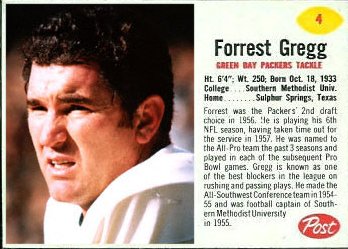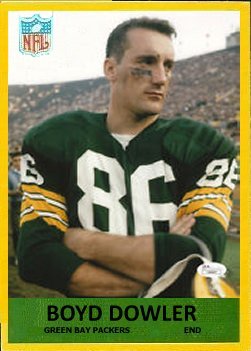Three renowned Packers share October 18 as their birthdays: Forrest Gregg in 1933, Boyd Dowler in 1937 and Jim Carter in 1948.
Here’s what Vince Lombardi said of Forrest Gregg in Run to Daylight: “Gregg is big enough and he’s strong enough and he handles the best defensive ends in the league. He’s a downfield blocker, too. His speed isn’t great, but he’s very quick off the ball and he has that mental sharpness to adjust to sudden situations. He has the knack of getting in front of the runner and with his excellent sense of timing, of making the important block. When you combine all this in an offensive tackle with his ability and willingness to play guard, you’ve got yourself quite a man.”
In, short, he was the textbook offensive tackle for his time. In addition, he and Jim Parker of the Colts were the only tackles of their era so quick and skilled that they also made All-Pro at guard when shifted inside. Gregg was drafted out of SMU in the second round of the 1956 draft by Green Bay and moved into the starting lineup as a rookie. From the second game of his rookie year through the end of the 1970 season, Gregg appeared in 187 consecutive games for the Packers — aside from spending the 1957 season in the military. The 6’4” 250 pounder was also the most versatile lineman on the team, playing right and left tackle as well as both guard positions, but he spent most of his time at right tackle.
Forrest received All-Pro recognition in each of the nine seasons that Vince Lombardi coached the team, and, with Boyd Dowler, is one of just two players to play in every game Lombardi coached in Green Bay.
Dowler was a track man who won the Wyoming 120-yard hurdles title and finished second in the broad jump while in high school. He also was timed at 9.9 in the 100-yard dash. The son of a high school football coach, Dowler played quarterback in a single wing offense at Colorado and actually led the Buffs in receiving. Drafted in the third round by Green Bay in 1959, Dowler reported with the quarterbacks to Vince Lombardi’s first camp but was quickly converted to flanker.
The 6’5” 220-pound Dowler was tough and durable. Dowler’s great size made him an effective enough blocker to fill in at tight end at times, and he was unafraid going over the middle, once telling Bud Lea, “Sure you get racked up. But it doesn’t hurt as much if you catch the ball instead of drop it.” He was also surprisingly fast with his long strides. On an earlier occasion, he told Lea, “If I’m free when I catch the ball, I feel I can outrun any defender.”
In Run to Daylight, Lombardi praised Boyd’s toughness, discipline and studiousness and added, “He is serious, intense and highly intelligent, and he is not one of those receivers who overrates himself and thinks he can get open on every play.” Dowler was no diva, but he was tall, savvy, steady, sure-handed and fast. He was selected for the 1960s NFL All-Decade team over Hall of Famers Bobby Mitchell, Tommy McDonald and Bob Hayes.
Jim Carter was a fullback at Minnesota when he was drafted in the third round in 1970. After briefly trying him at tight end, Green Bay converted the 6’3” 235-pound Carter to linebacker as a rookie. When Dave Robinson suffered a season-ending injury in the first month of the season, Carter moved into the starting lineup at strong side linebacker. Robinson returned in 1971, and new coach Dan Devine shifted the productive Carter to the middle, as noted above, to replace the legendary Ray Nitschke.
Compounding the fans displeasure with Nitschke’s benching was Carter’s belligerent attitude. In 1987, Carter looked back and admitted, “I was always popping off that I could do his job, that I was just as good as Ray. That was whiskey talk.” What was lost at the time was that Carter was a very solid linebacker, especially stout against the run. He told the Milwaukee Journal in 1975, “In the middle, they’re coming from both sides. You’re kind of the center of it all. Plus, you have the added responsibility of calling defensive signals and audibles.” Carter rarely blitzed and could not compare to Nitschke in pass coverage.
The other problem with Carter’s career was injuries. He was healthy for his first four seasons and was named to the Pro Bowl in 1973. After that, each year he dealt with injuries. Jim had knee problems in 1974, a broken leg and a knee injury in 1975, and missed 1976 entirely due to a broken arm. He returned for one last good season in 1977, but the 30-year old was beaten out by rookie Mike Hunt in 1978.
(Adapted from Green Bay Gold.)






Custom cards in a variety of years and styles; the 1958 Gregg is colorized.




















































